Is There A Way To Upload Stickers Into Lego Digital Designer
Adding Custom Decals into LEGO Digital Designer
As great as LEGO Digital Designer is, information technology doesn't contain all the textures always produced by the LEGO group. This tutorial will prove you how to modern in custom textures to LDD so that you lot can use them in your models, and includes a little section at the end on setting these models up for rendering in POV-Ray.
In social club to add custom decals into LDD, you will need the following:
- LIF Extractor past JrMasterModelBuilder
- Notepad++ (or whatever decent text editor, this is free and recommended)
- A decal in PNG format
Step 1: Preparing LDD
Before y'all tin add together in custom decals, you'll demand to prepare LDD for modding. To exercise this, you will use the LIF Extractor y'all downloaded previously. Navigate to your Awarding Data directory, and locate LDD's folder. On Windows seven this path should exist:
C:\Users\YOURUSERNAME\AppData\Roaming\LEGO Visitor\LEGO Digital Designer
Inside you will observe, among other files, a large file called db.lif . This file contains all the decorations that are loaded into LDD, in addition to various other files.
Spoiler

Now open up the LIF Extractor in a new window. Navigate within the folder relevant to your operating system - for my 32 bit computer, this is LIF_Extractor_Win_32bit . Drag the db.lif file onto the LIFExtractor.exe file within, and information technology will begin the extraction process. This might take a while depending on your computer - on my Windows 7 netbook it took almost an 60 minutes, only on my old Windows XP laptop information technology took about a minute - and then feel free to pop off to the nearest Support Station for a sandwich. Practise not get impatient; just wait for the command window to disappear. In one case it does, the extraction is complete.
Spoiler

Ta-da! You'll see a shiny new binder called db sitting next to the db.lif file. Now, to fix LDD to run from this folder rather than the db.lif file, simply rename the db.lif file to something else (don't delete it - you'll want to keep it as a fill-in). In this example I'll rename it to originaldb.lif . Your folder should now look like this:
Spoiler
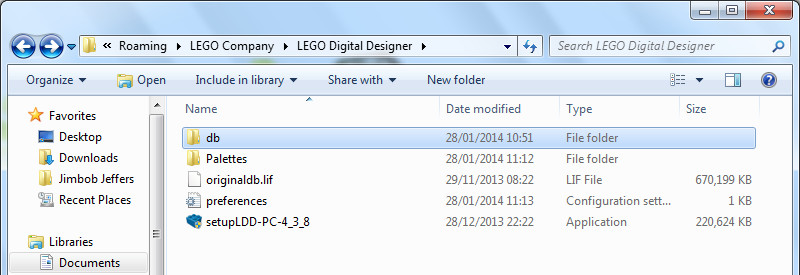
That's information technology, Footstep ane is complete and y'all're all fix!
Pace 2: Calculation Custom Decals
Now to the main part of this tutorial. Calculation custom decals into LDD is actually very easy, and you probably won't need to refer to this tutorial any more afterwards your first few tries.
Open the db binder y'all extracted in Footstep 1. There are several files and folders here, but the only ii we're concerned with are Decorations and DecorationMapping . I have highlighted them in the image below.
Spoiler
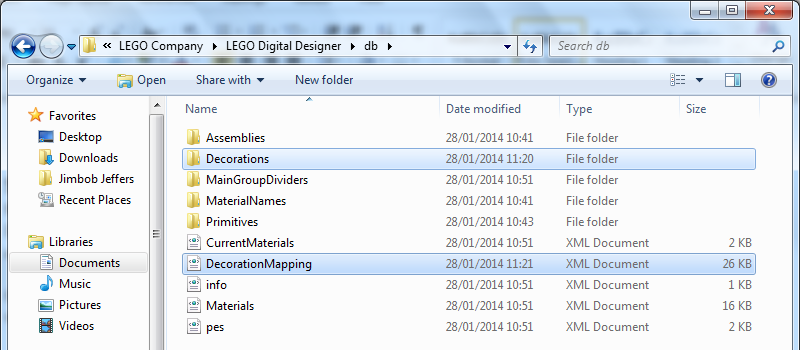
The Decorations folder contains over ane,500 PNG images, all of which are used as decals on bricks and minifigure parts. The DecorationMapping.xml file is just 1 big list of all these files, and tells LDD which parts these decals should exist bachelor to.
To add together your own decal into LDD, simply save it in PNG format (if it isn't already) and copy it into the Decorations folder. The of import matter is that you lot must now name information technology with a unique 5-digit number (plus the extension, of course). You tin can give it any number, and so long as no other file in that binder already has it, so in this example I volition utilize 10001.
Spoiler
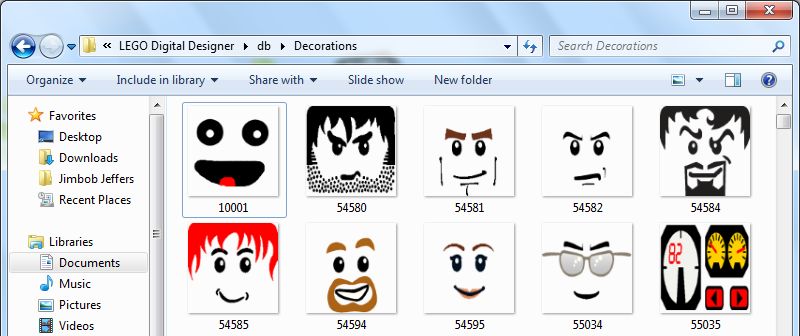
Hither you lot can see I've created a masterpiece of a face decal and placed it in the Decorations binder. At present that the decoration is in the correct location, go back out into the db folder, and open DecorationMapping.xml in Notepad++ (or another decent text editor). You will run into, subsequently the first two lines, an indented listing many lines in length. The format is:
<Mapping decorationID="54580" designID="3626" surfaceID="1"/>
The decorationID number is the name you gave your decal in the Decorations folder, excluding the extension. If yous remember, in this example it is 10001. The designID number refers to the part that the decoration can exist placed onto - in this example, it is 3626, which is the minifigure caput slice.
Tip: To observe out the number of a item piece, wait for a decal that the relevant slice currently uses in the Decorations folder (for example, 55071). Then search this number in the DecorationMapping.xml file, and the associated designID is the part's ID (55071 has designID 3070, hence the 1x1 tile piece's ID is 3070).
My custom ornamentation is intended to be used on a minifigure's head, so I'll get out it as 3626. Copy any line you wish and paste information technology at the summit of the listing, afterwards the first ii lines (or manually blazon a new one). Then change the decorationID to your decal's name, and the designID to your office's ID. By placing your decoration at the summit of the listing, LDD will read it first, so information technology will announced at the superlative of the decorations list in the application.
Spoiler
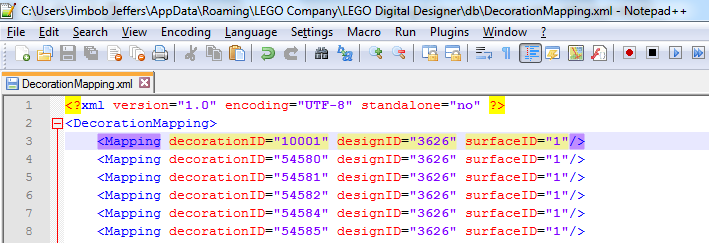
Relieve the file, close information technology, and you're done!
Step 3: Checking Out Your New Decal
Launch LDD and enter LDD Extended style. You can do this by selecting View > New themes > LDD Extended. Place the part you added a new decal to, select the Decoration tool (found by offset selecting the Paint tool), and click on your model. If all goes well, the first decoration in the listing should exist your newly modded one!
Spoiler
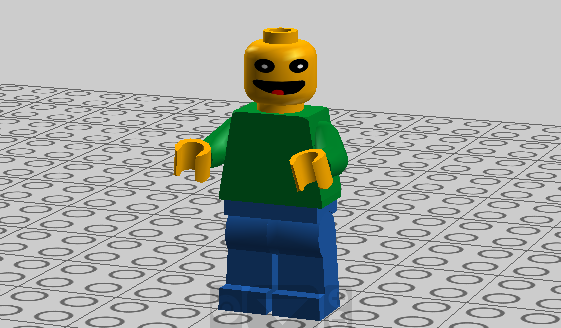
Only what happens if you lot want to distribute this file? Well, the ornamentation ID of each part is saved to the file. If you save your model with a custom decal on it, then load it into an unmodded (or modded without the electric current decal in it) version of LDD, it simply won't announced. The part is still registered as containing that decal though, equally mentioned previously, and therefore if y'all open up the file in a correctly modded version of LDD information technology volition reappear once again.
This means that you lot tin can distribute your .LXF files either with standard decals, for users with unmodded version of LDD, or containing the modded files so that other people tin use them as well. Or both, which is probably improve.
One concluding note: le717 pointed out that updating LDD will cause any electric current mods to be lost, so you will need to backup your decals somewhere else and reinsert them into LDD each time there is an update, starting from Step 1 of this tutorial.
Rendering Models with Custom Decals
You've just finished building an Awesome model using custom decals, and desire to render it in POV-Ray*. Merely the POV-Ray converter requires that you use an unmodded version of LDD, so what do y'all practise? Information technology's very unproblematic. Afterwards saving your model, change all the decals in it to whatever standard decals that LDD uses by default. Save a new copy of the file, and then rename your originaldb.lif file back to db.lif . When you load the LDD-to-POV-Ray converter, there is an option to render with custom decals. Just tick this, and supplant all the decals with your own ones.
Recollect, if y'all want two of the same part (a minifigure'southward head, for example) to use dissimilar decals in the same model, you will need to give them both dissimilar standard caput decals. The LDD-to-POV-Ray converter changes each individual decal for all parts that use it in a model.
*Not certain how? Bank check out le717'due south tutorial here.
Edited past JimbobJeffers
Fixed epitome links
Source: https://rockraidersunited.com/topic/5399-tutorial-adding-custom-decals-into-ldd/
Posted by: byrdwhimor.blogspot.com

0 Response to "Is There A Way To Upload Stickers Into Lego Digital Designer"
Post a Comment